The 1980 Geneva Motor Show saw the debut of an automobile, whose name went on to become more than just a symbol for a long line of success by the manufacturer. The quattro from Audi is also the gold standard for the combination of winning motor sport qualities with the utmost in everyday practicality.
In celebration of the 30th anniversary of the debut of the quattro, Audi is presenting a show car at the 2010 Paris Motor Show that moves a futuristic interpretation of this concept into the fast lane: the Audi quattro concept, a thoroughbred driving machine with 300 kW (408 hp), five-cylinder turbocharged engine, a lightweight body and – of course – the latest generation of quattro permanent all-wheel drive.
The very first glimpse of the new Col de Turini White show car awakens memories of another legendary ancestor: the 1984 Sport quattro, a 306 hp evolutionary stage of the Audi quattro Coupé with a shortened wheelbase. In fact, the Audi quattro concept also represents the systematic further development of a production coupé using high-performance technology. The foundation is provided by the powerful Audi RS 5, one of the brand’s sportiest production vehicles ever.
The Audi development engineers shortened the wheelbase by 150 millimeters (5.91 in) and lowered the roofline by around 40 millimeters (1.57 in) compared to the four-seat coupé on which it is based. Like its predecessor from 1984, the 2010 show car is now also a two-seater. The heavily modified body is made primarily of aluminum, with the hood, the rear hatch and other components made of carbon.
The low weight of the superstructure leads to significant secondary effects in other components of the vehicle, such as the transmission, the chassis and the brake system. As a result, the Audi quattro concept weighs just 1,300 kilograms (2,866.01 lb), almost exactly the same as the Sport quattro from 1984. This once again moves Audi, the pioneer of lightweight construction, to the head of the pack.
The know-how and technologies of the quattro concept body will characterize Audi’s entire production model portfolio in the future.
In another move that benefits the vehicle’s weight, the eight-cylinder engine from the production model has been replaced under the hood by a turbocharged, inline five-cylinder engine that can trace its roots back to another Audi sports car – the TT RS. In the Audi quattro concept, the longitudinal FSI turbo produces 300 kW (408 hp) and accelerates the car from 0 to 100 km/h (62.14 mph) in only 3.9 seconds. Torque is distributed as needed via a six-speed manual transmission.
The Audi quattro concept uses the latest evolutionary stage of the quattro permanent all-wheel drive system to deliver its power to the road. The key innovation, the crown-gear center differential, is compact, lightweight, and can vary the distribution of power between the front and rear axles over a broad range, enabling the quattro drive system to react within milliseconds to coax the maximum of fun and safety out of every last bit of torque.
Design
Brawny, compact, powerful: The appearance of the Audi quattro concept makes no secret of its potential. Although the genes of the elegant Audi A5 and RS 5 Coupés are impossible to overlook, the appearance of the show car is far more aggressive and extroverted. Even the obvious differences between the base model and the evolution are more dramatic than between the Ur-quattro and the Sport quattro in 1984.
The concept car’s wheelbase is 150 millimeters (5.91 in) shorter than that of the RS 5. The primary reason for this, of course, was to enhance agility and reduce weight – form follows function.
In contrast to Sport quattro, the Audi designers also shortened the rear overhang by a total of 200 millimeters (7.87 in) to maintain the harmony of the basic proportions. Roof height was reduced by 40 millimeters (1.57 in) for this same reason.
With its exterior dimensions (length x width x height) of 4.28 m (14.04 ft) x 1.86 m (6.10 ft) x 1.33 m (4.36 ft) and wheelbase of 2.60 m (8.53 ft), the Audi quattro concept fits neatly into the sports car segment.
The low roof also reduces the height of the greenhouse and thus lowers the vehicle’s visual center of gravity. The muscular C-pillar is clearly an homage to the design of the Ur-quattro. As with that model, the trademark four rings can be found at the transition to the side of the vehicle, but in this case they are stamped into the sheet metal. Together with the large center-locking, 20-inch wheels in a 7-twin-spoke design, the lines make for extremely dynamic and powerful proportions when viewed from the side.
The wheel wells in the arched fenders are prominently flared – another quote from the design language of the Sport quattro. The same applies to the distinctive air outlet on the right side of the hood, which allows the five-cylinder engine to breathe more freely.
A significant feature of the front end is the stark single-frame grille. The elimination of the chrome frame lends it a functional and technical character. Large, upright air intakes at the corners of the bumper underscore the performance of the power plant.
The top of the grille merges into the flat strips of the headlight modules with their clear glass covers. All light units use ultra-efficient LED technology. The LED elements change their appearance between a horizontal and a vertical arrangement and thus change the character of the front end of the vehicle depending on the lighting function activated.
The strongly molded front skirt includes integrated carbon elements. This lightweight, yet extremely strong material is also used for the rear hatch and the hood, which are unpainted on the inside in order to use the visual quality of the material as a design element. The large spoiler integrated into the rear hatch is also made of carbon and extends automatically as needed and can be adjusted for maximum downforce.
Interior
The interior of the coupé is reduced and clean. The dashboard is very slender and seems to float over the separate center console. Shortening the wheelbase meant losing the rear seat of the RS 5 on which it is based. In its place is a shelf for helmets or luggage. Awaiting the two occupants are filigree bucket seats, during whose development the issue of lightweight design played a central role. They weigh only 18 kilograms (39.68 lb) each – a weight advantage of roughly 40 percent versus a conventional production seat. The seats are equipped with either three- or four-point belts.
Awaiting the driver is a clearly organized workplace that exudes quality from its carbon surfaces and upholstered leather inlays. The color scheme with satin black for the carbon elements and rally beige for all of the leather areas offsets the various functional units from one another and emphasizes the handcrafted character of the interior.
The classic driver orientation (“wrap-around architecture” in the designer jargon) of the cockpit is typical Audi. The control unit for the MMI touch system and the shift lever for the six-speed transmission are located on the extremely slender center console.
The instrument cluster is completely digital. The large, three-dimensional visor-like display contains all of the information required by the driver and thus also replaces the classic MMI central display. The clear graphics, the stark black-and-white contrast and the subtle red highlights are precise and modernly interpreted – an indicator instrument for a driving machine, with no superfluous touches. The driver has the choice between an everyday mode, which combines the indication of the speed and engine revs with the content of the MMI, and racing mode, whose graphics revisit and refine the digital instrument of the Ur-quattro from the 1980s.
The driver will find another reminder of the Ur-quattro’s cockpit on the sides of the cockpit cowl: On both the right and left sides are four flat buttons. The ones on the left control the stopwatch function in racing mode, and the ones on the right are for the menu of the MMI system.
Infotainment
Entertainment is offered not just under the hood, but also in the form of digital media. A customizable web radio can use the driver’s cellular phone to connect to digital radio stations all over the world, if desired, for a sheer endless array of genres and musical styles. Playback of the driver’s own files and playlists is also supported.
Communication also benefits from access to corresponding online services. Whether the online address book or the driver’s own cellular phone, the MMI combines all data into a single view. Contacts are always available wherever the user happens to be.
To pay proper respect to the Ur-quattro as the winner of numerous rally world championships, a so-called “prayer book” – the classic rally copilot’s track description – can be displayed in racing mode. It provides precise information about the route ahead for an authentic rally feeling – even if a copilot is not available.
Body
A true sports car is always a light car, and the Audi quattro concept shines in this discipline as well.
The key factors are the choice of material and the design. Rather than mostly steel as in the Audi RS 5, the body comprises lightweight aluminum components assembled using Audi Space Frame ASF technology. Extruded sections, die-castings and aluminum sheets form an impact-resistant structure of exceptional strength. The hood and the rear hatch with its integrated, moveable spoiler, plus the bumpers and numerous aerodynamic components are made of even lighter and high-strength carbon.
The body-in-white of the coupé weighs just 159 kilograms (350.53 lb); it would be nearly 50 percent heavier if made entirely of steel.
The low weight of the superstructure leads to significant secondary effects regarding size and weight in other components of the vehicle, such as the transmission, the chassis and the brake system. All together the Audi quattro concept tips the scales at just 1,300 kilograms (2,866.01 lb), which is roughly 200 kilograms (440.92 lb) lighter than even the comparably sized Audi TT RS, whose body is also largely made of aluminum.
The power-to-weight ratio of 4.3 kilograms (9.48 lb) per hp already says a lot about the car’s dynamic potential. It is on par with that of the 525 hp Audi R8 V10, a veritable supercar. The quattro concept also has a much better power-to-weight ratio than its Sport quattro predecessor. Although the Sport quattro weighed the same, the production version of its five-cylinder engine only developed 306 hp.
Engines and transmissions
The allure of the five-cylinder engine
High-performance five-cylinder gasoline engines enjoy a long tradition at Audi, powering cars like the Ur-quattro to the head of the pack. Audi resurrected this line back to life in 2009 with the 340 hp, turbocharged FSI engine in the TT RS. The further developed engine in the Audi quattro concept extracts even more potential from this new, state-of-the-art five-cylinder foundation.
Numerous tweaks resulted in a substantial power increase to 408 hp, and its 480 Newton meters (354.03 lb-ft) of torque also leave the base version far behind.
Its basic concept makes an Audi five-cylinder an unusual engine. It has a firing interval of 144 degrees and a firing order of 1-2-4-5-3, alternately between directly adjacent cylinders and cylinders that are far apart.
This produces the distinctive rhythm and musical sound, which are also the result of the intake and exhaust geometry. A specially designed torsional vibration damper at the front end of the crankshaft compensates for the free moments of the engine.
Turbocharged gasoline engines are a traditional Audi domain, and the five-cylinder turbo in the Audi quattro concept is also a high-performance engine. Displacing 2,480 cubic centimeters, it produces 300 kW (408 hp) between 5,400 and 6,500 rpm. Peak torque of 480 Nm (354.03 lb ft) is already available at 1,600 and remains constant through 5,300 rpm. The powerful unit accelerates the Audi quattro concept from 0 to 100 km/h (62.14 mph) in just 3.9 seconds.
The 2.5 liter TFSI is extremely compact. Its cylinder spacing measures 88 millimeters (3.46 in); the external main bearings were moved inside. Only 494 millimeters (19.45 in) long, the long-stroke engine (bore x stroke 82.5 x 92.8 millimeters [3.25 x 3.65 in]) is suitable not only for transverse installation in the TT RS, but also for longitudinal installation in the emphatically short front end of the Audi quattro concept.
Its low weight of only 183 kilograms (403.45 lb) is also a record. It helps keep the total weight of the show car low and also offers significant advantages for the distribution of axle loads and thus for the car’s handling.
The 408-hp five-cylinder engine is surprisingly frugal, requiring an average of just 8.5 liters/100 km (27.67 US mpg). Its high efficiency can be attributed to the combination of FSI direct fuel injection and turbocharging, two Audi core technologies. This TFSI pairing harmonizes perfectly in motorsports, the world’s most demanding test lab: It has powered the R8 race car to five victories in the 24 Hours of Le Mans and 63 victories in 80 other races.
The successful quattro principle
In the Audi quattro concept, Audi uses the latest evolutionary stage of its permanent all-wheel drive system for longitudinal engines – the quattro drive with self-locking crown-gear center differential and torque vectoring. 30 years after the debut of the first quattro at the Geneva Motor Show in 1980, Audi has once again expanded its lead over the competition.
Inside the new center differential are two rotating crown gears that owe their name to the crown-like design of their teeth. The front crown gear drives the output shaft to the front differential, the rear crown gear the propshaft to the rear axle. The connection here is provided by an ambitious construction. The new drivetrain design is roughly 3 kilograms (6.61 lb) lighter than the previous one.
The crown gears mesh with four rotatable pinion gears. They are arranged at right angles to each other and are driven by the differential’s housing, i.e. by the transmission output shaft.
Under normal driving conditions, the two crown gears rotate at the same speed as the housing. Because of their special geometry, they have specifically unequal lever effects. Normally 60 percent of the engine torque goes to the rear differential and 40 percent to the front differential.
If the torques change because one axle loses grip, different speeds and axial forces occur inside the differential and the integrated plate packages are pressed together. The resulting self-locking effect now diverts the majority of the torque to the axle with the better traction; up to 85 percent can flow to the back. In the opposite scenario – if the rear axle has less traction – the same happens in reverse; now up to 70 percent of the torque is diverted to the front axle.
With this extremely broad torque distribution range, the crown-gear center differential surpasses its predecessors – grip becomes even better. Forces are redistributed without any time lag and absolutely consistently. The mechanical operating principle guarantees maximum efficiency and immediate response. Other strong points of the crown-gear differential are its compactness and low weight – at 4.8 kilograms (10.58 lb) it is roughly two kilograms (4.41 lb) lighter than the previous unit.
Like on rails: quattro with sport differential
As a complement to the new quattro drivetrain, the Audi quattro concept also features the sport differential, which actively distributes torque between the rear wheels. When turning into or accelerating in a curve, the majority of the torque flows to the outside wheel and pushes the vehicle into the curve, nipping the tendency to oversteer or understeer in the bud.
The sport differential is a state-of-the-art rear differential. A superposition gear comprising two sun gears and an internal gear was mounted on the left and the right of a conventional rear differential. It turns 10 percent faster than the drive shaft.
A multi-plate clutch in an oil bath and operated by an electrohydraulic actuator provides the power connection between the shaft and the superposition gear. When the clutch closes, it steplessly imposes the higher speed of the superposition stage on the outside wheel. The additional torque required in order to rotate faster is drawn away from the inside wheel via the differential. In this way nearly all of the torque can be directed to one wheel. The maximum difference between the wheels is 1,800 Nm (1,327.61 lb-ft).
Chassis
The high-performance Audi quattro concept dazzles with extreme driving dynamics. It reacts without hesitation, almost reflexively. Its handling is uncompromisingly precise; its stability guarantees maximum driving safety. The steering connects the driver with the road to provide sensitive, finely differentiated feedback.
The wide tracked chassis is rigorously tuned for performance. All of the key suspension components are made of aluminum, thus reducing the unsprung masses. The springs and dampers of the track-controlled trapezoidal link rear suspension are separated to improve response behavior. The links are mounted on a steel subframe on elastic bearings. The five-link front suspension processes the longitudinal and lateral forces separately. The rigid aluminum frame to which it is linked makes the front end extremely rigid.
Up front are anthracite gray, drilled carbon fiber-ceramic discs. They are gripped by red-anodized, six-piston fixed calipers. The ceramic discs are practically fade-free, extremely robust, powerful and durable. Furthermore, they are four kilograms (8.82 lb) lighter than steel discs despite their size.
The Audi quattro concept rolls on large cast aluminum wheels in seven twin-spoke design. The 9J x 20 wheels are shod with 275/30 tires. Like the Audi R8 LMS GT race car, the wheels of the Audi quattro concept have a central locking mechanism for fast changes.
Story by Audi AG
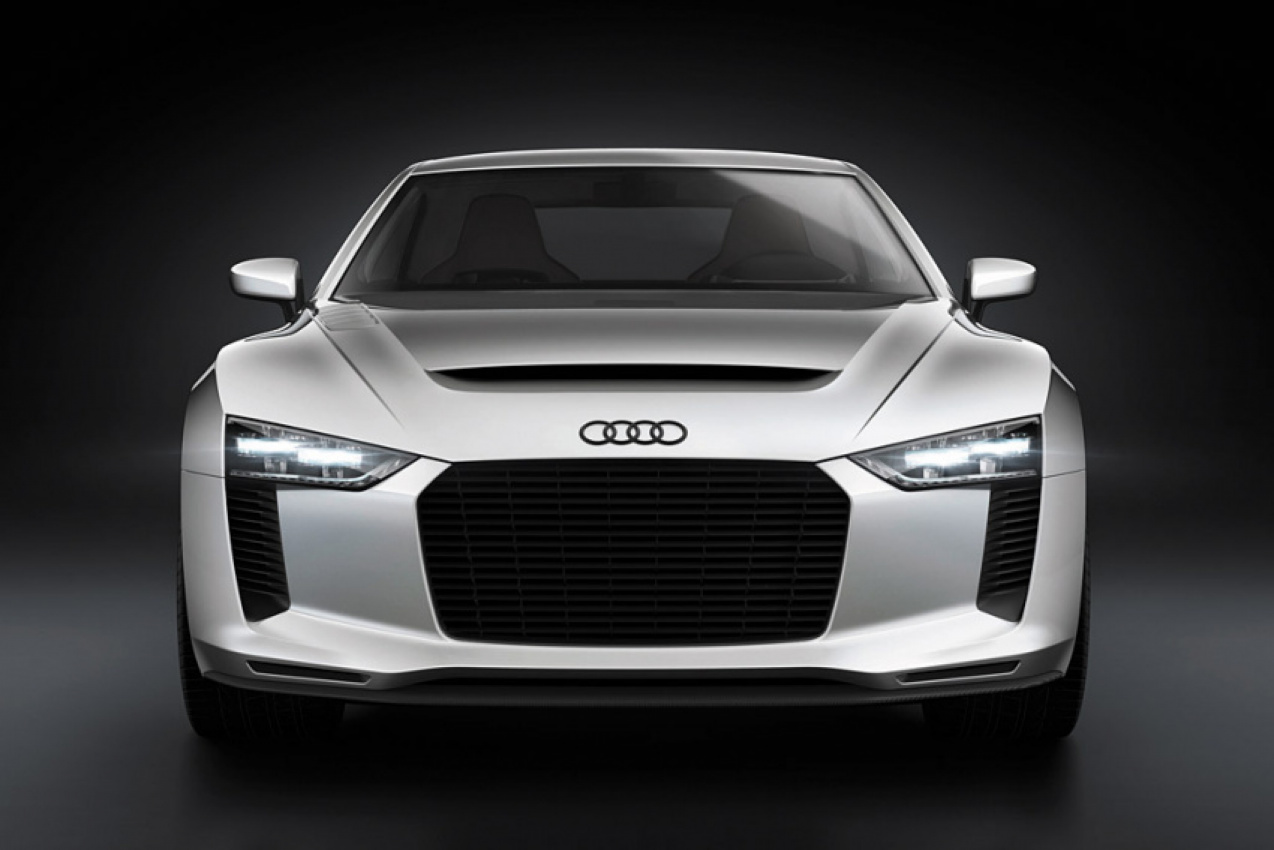
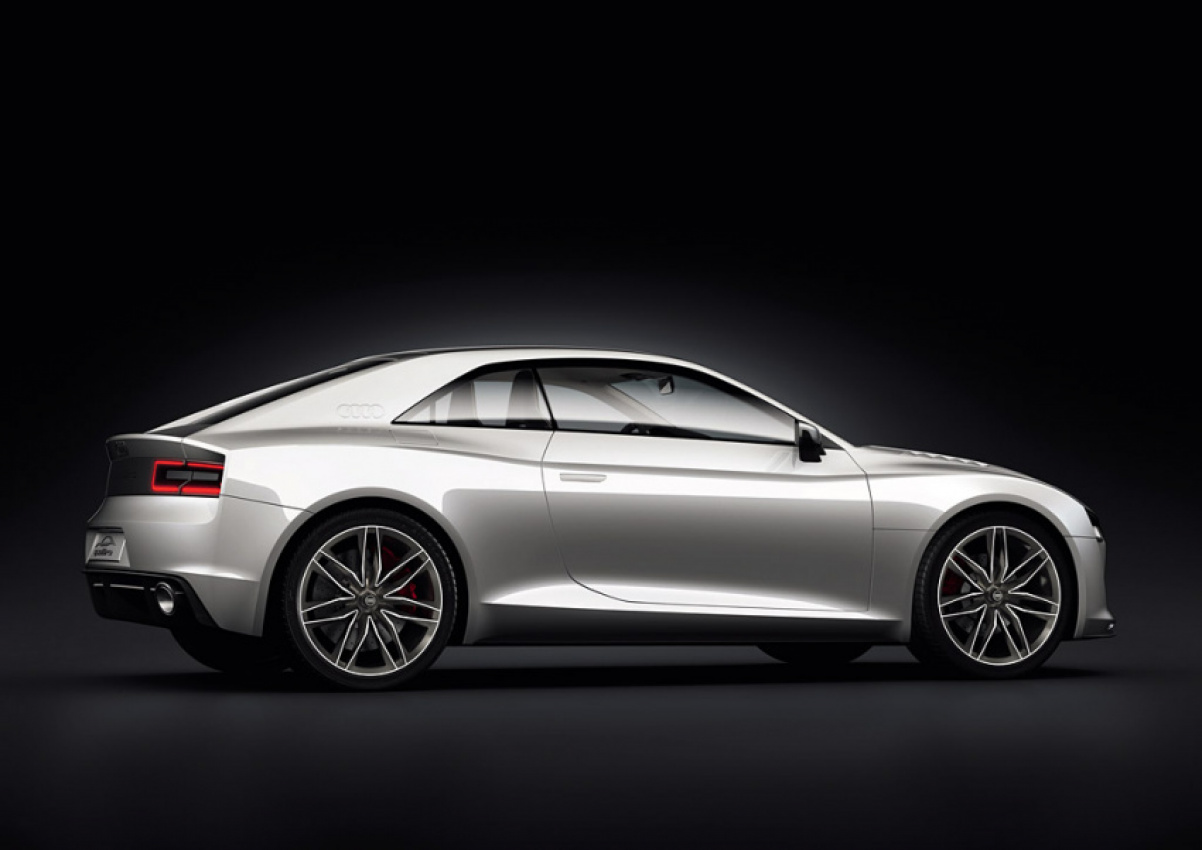
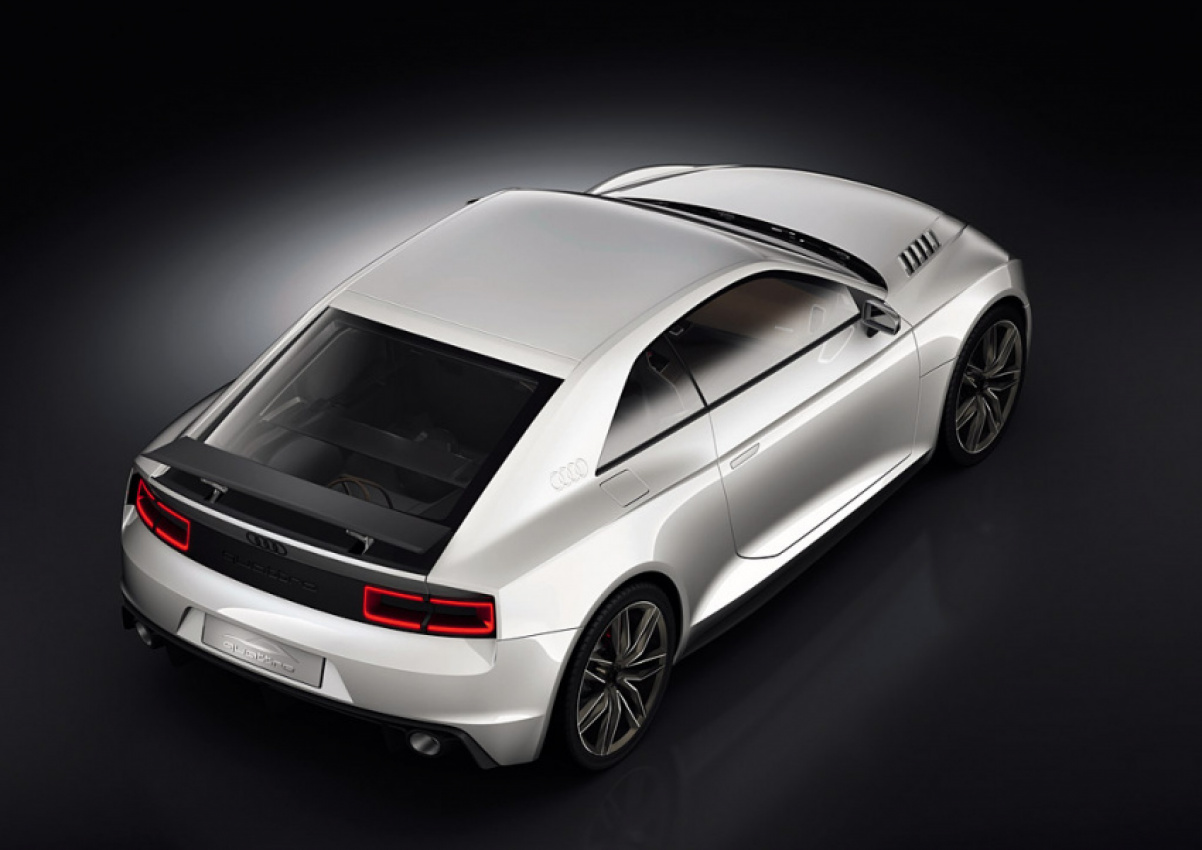
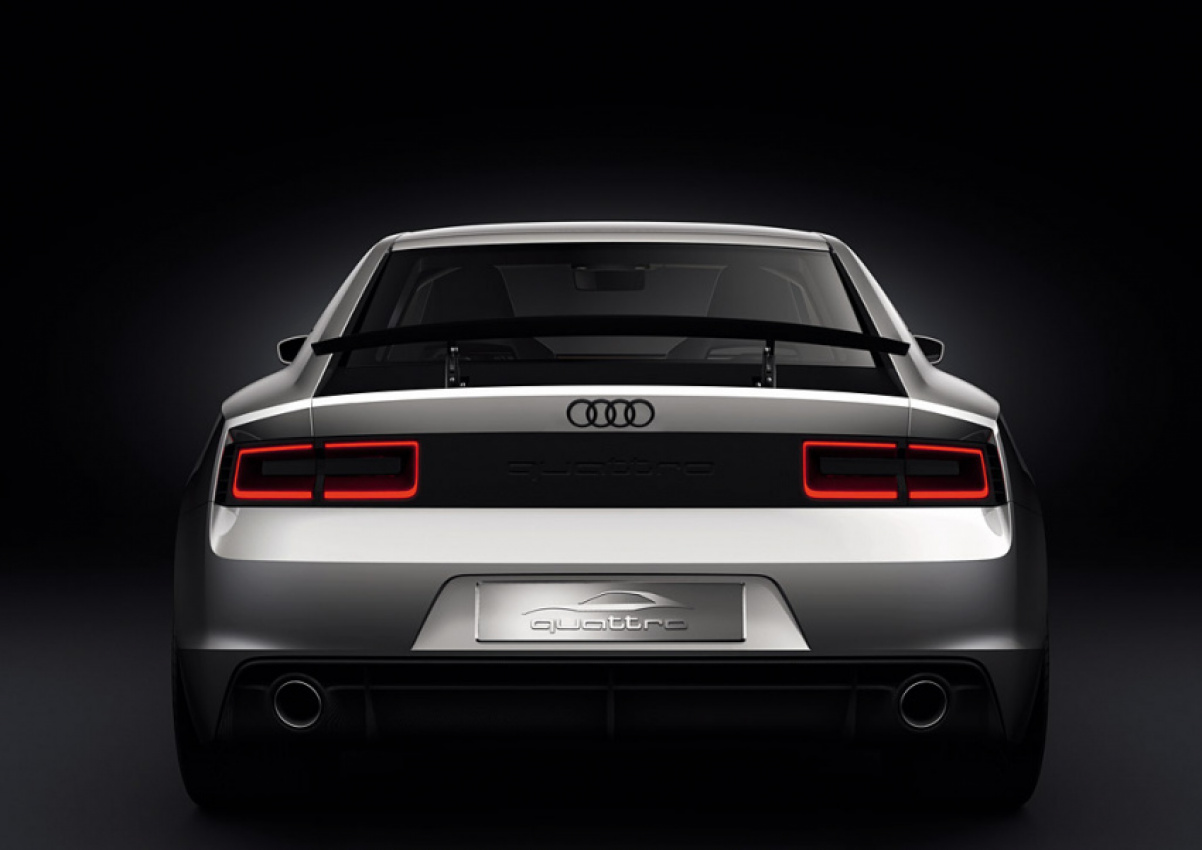
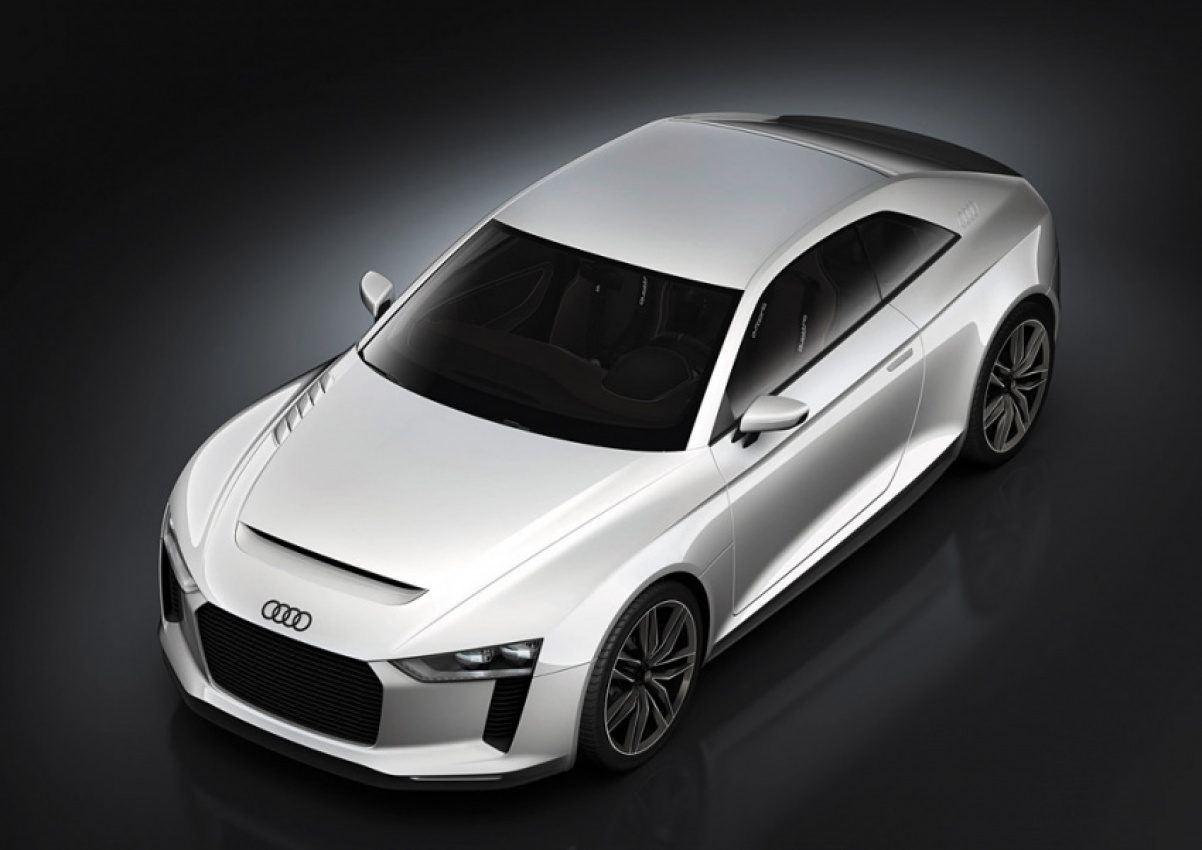
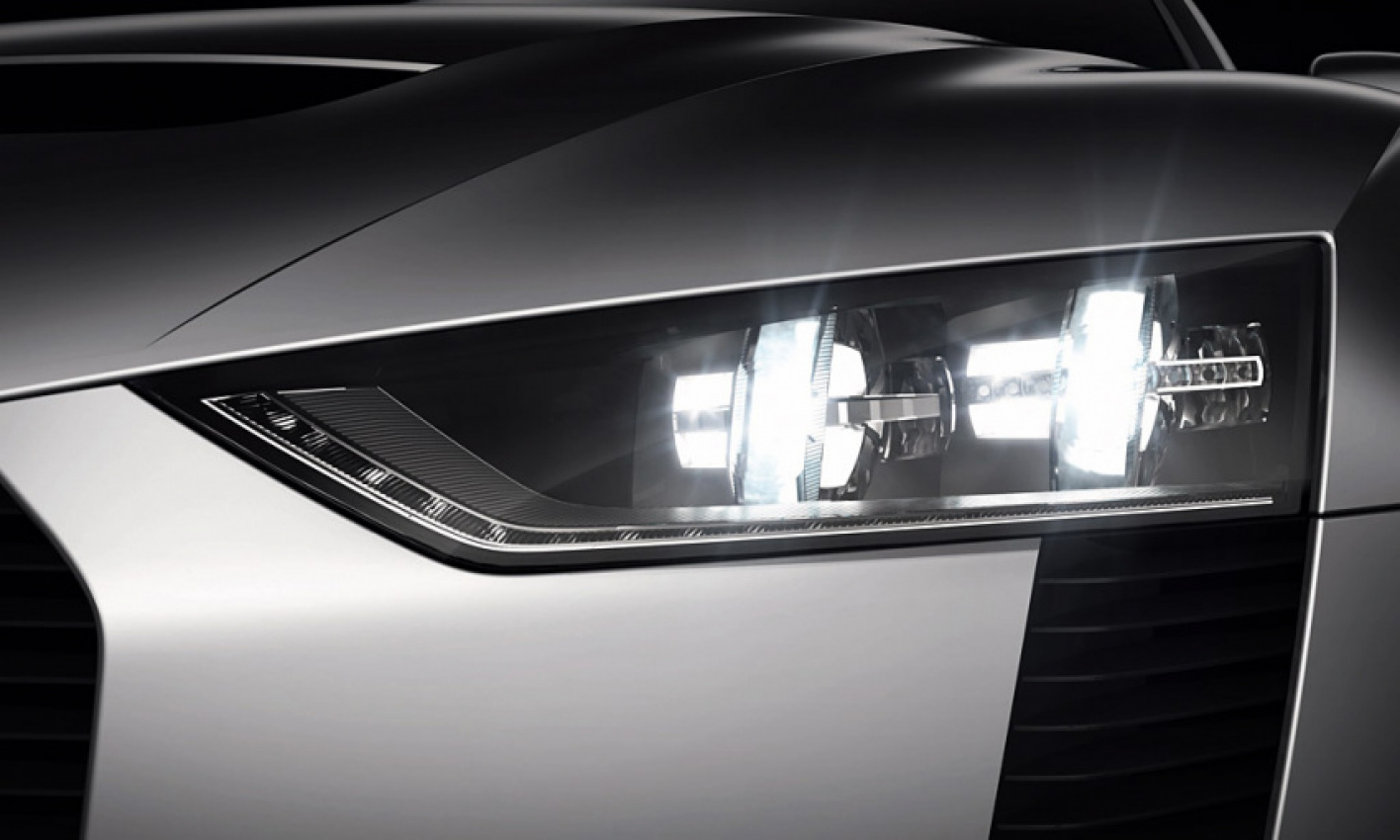
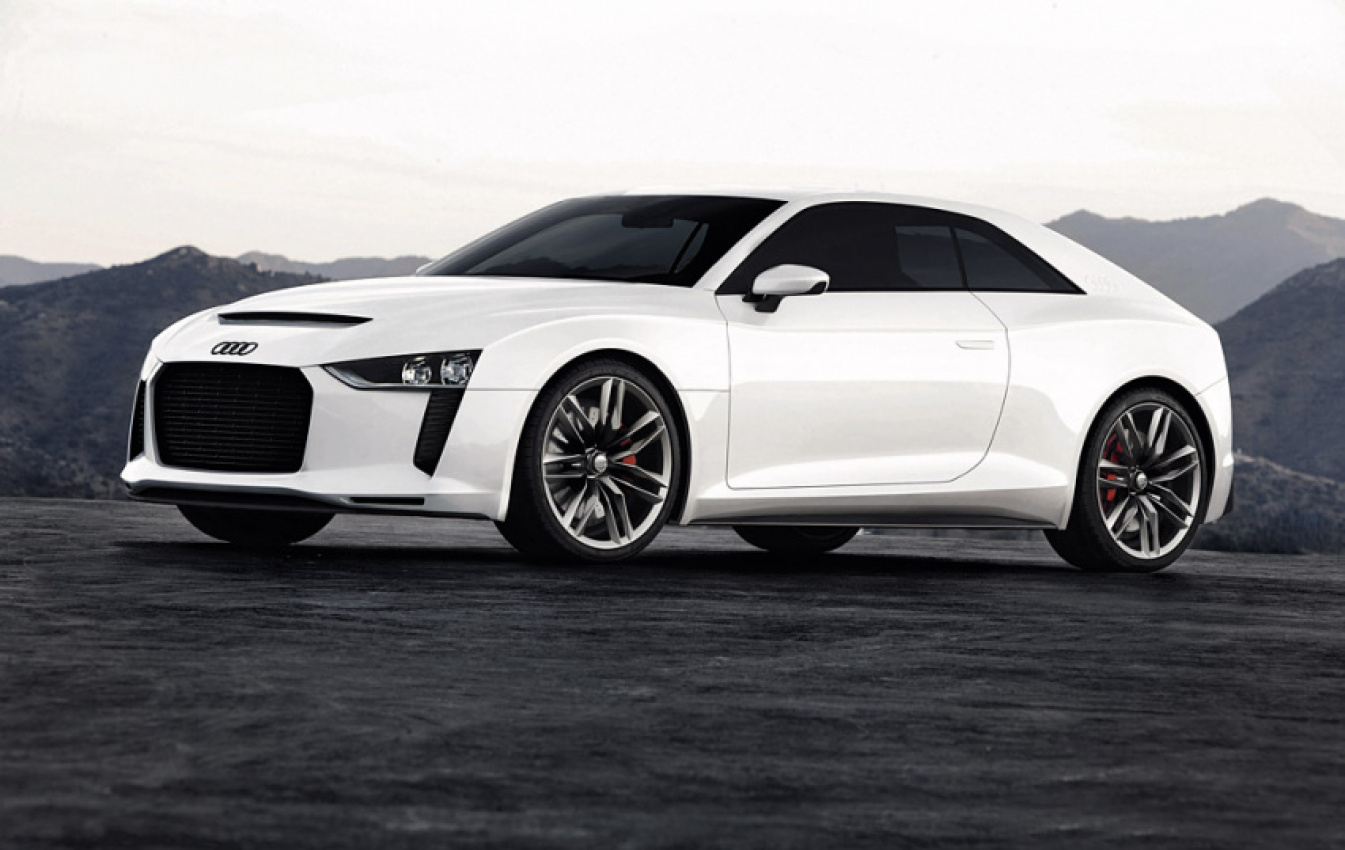




In Detail
| type | Concept / Prototype Car |
| released at | 2010 Paris Motor Show |
| production | 1 |
| engine | 2.5 R5 20v TFSI Inline-5 |
| position | Front, Transverse |
| aspiration | Turbocharger |
| ignition | Electronic, Coil on Plug |
| block material | Cast Iron w/Aluminium Alloy Cylinder Head |
| valvetrain | Chain-Driven DOHC, 4 Valves per Cyl |
| fuel feed | Direct Gasoline Injection |
| displacement | 2480 cc / 151.34 in³ |
| bore | 82.5 mm / 3.2 in |
| stroke | 92.8 mm / 3.7 in |
Keyword: 2010 Audi quattro concept
